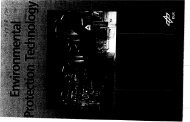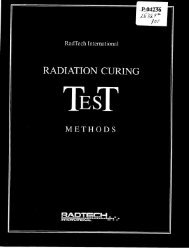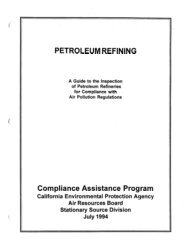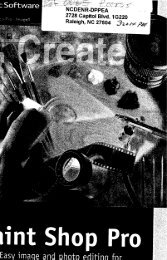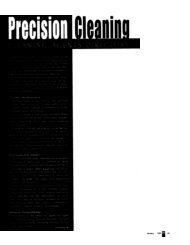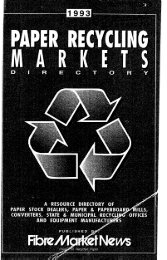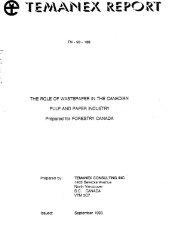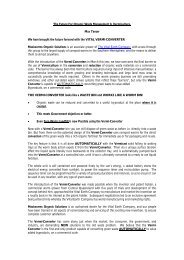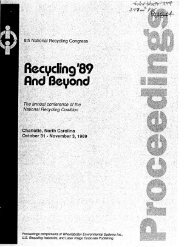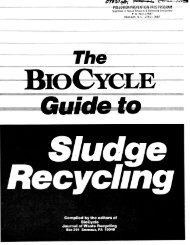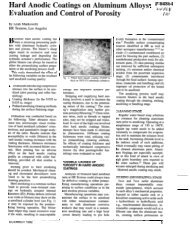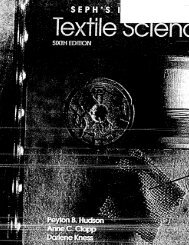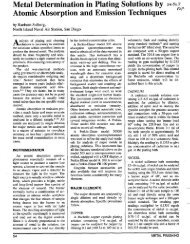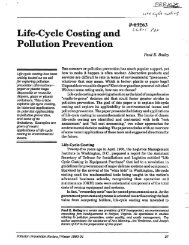Electronic Parts/Guidelines - infoHouse
Electronic Parts/Guidelines - infoHouse
Electronic Parts/Guidelines - infoHouse
You also want an ePaper? Increase the reach of your titles
YUMPU automatically turns print PDFs into web optimized ePapers that Google loves.
"1<br />
. I<br />
~<br />
PLANT WASTE<br />
dunnage, shipping, packaging, storage, and<br />
general office waste. Not production or<br />
process wastes. ( I )<br />
PLASTIC RECYCLING<br />
a process by which plastic materiais which<br />
would otherwise become solid waste are<br />
collected. separated, or processed and<br />
retumed to the economic mainstream in<br />
the form of useful raw materials or products.<br />
(5)<br />
POLLUTION<br />
the condition caused by the presence in<br />
the environment of substances of such<br />
character and in such quantities that the<br />
quality of the environment is impaired or<br />
rendered offensive to life. (2)<br />
POLYMERIC<br />
a substance made of plastic.<br />
POST CONSUMER RECYCLED MATERIALS<br />
materials produced from products generated<br />
by a business or consumer which<br />
have served their intended end uses, and<br />
which have been separated or diverted<br />
from solid waste for the purpose of coilection.<br />
recycling and disposition.<br />
POSTCONSUMER RECYC4lNG<br />
the reuse of materials generated from residential<br />
and commercial waste, excluding<br />
recycling of material from industrial processes<br />
that has not reached the consumer,<br />
such as glass broken in the manufacturing<br />
process. (7)<br />
POSTCONSUMER WASTE, (PCW)<br />
any waste product that has gone through<br />
its useful life, served the purpose for which<br />
It was Intended and has been discarded by<br />
the user. This is in contrast to preconsumer<br />
waste or scrap from manufacturing.<br />
PRECONSUMER RECYCLED MATERIALS<br />
those materials that cannot be reused in<br />
the manufacturing process and would otherwise<br />
bedEFosea.~ofas solid waste.<br />
These materiais do not include virgin materials,<br />
nor does it include the virgin content<br />
of scrap or by-products generated and<br />
reused within the original product manufacturing<br />
process.<br />
PRE-CONSUMER WASTE<br />
materials discarded .from industrial oper-<br />
ations or derived from manufacturing proc-<br />
esses.<br />
PRIMARY MANUFACTURING RESIDUES<br />
sawdust, chips, slabs and the like created<br />
from the basic conversion of roundwood<br />
into a lumber product. Sawmills and<br />
plywood and veneer milis are the principal<br />
operations creating primary manufacturing<br />
residues from their processing operations.<br />
(1)<br />
PRIMARY MATERIALS<br />
virgin or new materiais used for manufacturing<br />
basic products. Examples include<br />
wood pulp, iron ore and silica sand. (1)<br />
PRIMARY PACKAGE<br />
the first layer of packaging that comes in<br />
direct contact with the part.<br />
PRIMARY RECYCLING<br />
the return of a secondary material to the<br />
same industry from which it came and<br />
processing that material so that it will yield<br />
the same or similar product which it was<br />
originally as a secondary material. Examples<br />
are the return of broken glass containers<br />
to glass container manufacturing<br />
plants for making new containers and the<br />
recycling of sheet steel scrap to steel furnaces<br />
for the manufacture of new sheet<br />
steel.<br />
PROCESS WASTE<br />
the waste material from an industrial<br />
process. Examples of process wastes are<br />
flue gas scrubber sludges, cement kiln<br />
dusts, sawmill dust and powder, spent so!-<br />
vents, contaminated oils, etc. (I)<br />
PROCESSING WASTES<br />
any method, system, or other treatment<br />
designed to beneficially change the physical,<br />
chemical, form or content of waste<br />
material. (1)<br />
PRODUCTS OF COMBUSTION<br />
the gases, vapors, and solids that result<br />
from the combustion of a material. (1)<br />
PRODUCT STEWARDSHIP<br />
assuming responsibility for a product and<br />
it's packaging from conception to disposal.<br />
PULVERIZATION<br />
the crushing or grinding of material into<br />
very fine particle size. (1)<br />
Appendix 6. Glossary of Terms 95



